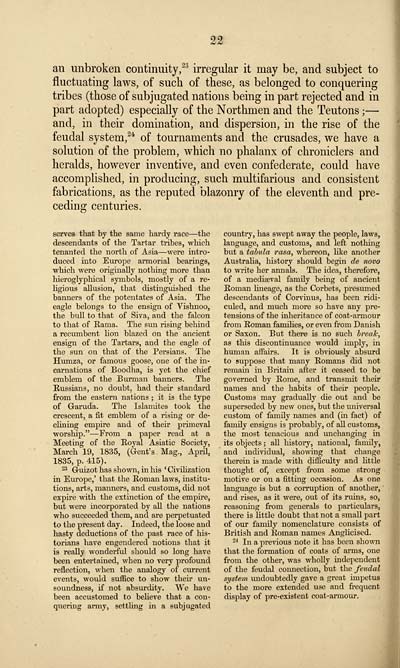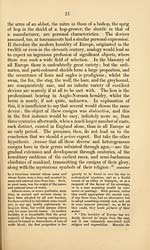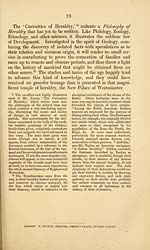Notices of the Ellises of England, Scotland, and Ireland, from the conquest to the present time
(362) Page 358
Download files
Complete book:
Individual page:
Thumbnail gallery: Grid view | List view

22
an unbroken continuity, 23 irregular it may be, and subject to
fluctuating laws, of such of these, as belonged to conquering
tribes (those of subjugated nations being in part rejected and in
part adopted) especially of the Northmen and the Teutons ; —
and, in their domination, and dispersion, in the rise of the
feudal system, 24 of tournaments and the crusades, we have a
solution of the problem, which no phalanx of chroniclers and
heralds, however inventive, and even confederate, could have
accomplished, in producing, such multifarious and consistent
fabrications, as the reputed blazonry of the eleventh and pre-
ceding centuries.
serves that by the same hardy race — the
descendants of the Tartar tribes, which
tenanted the north of Asia — were intro-
duced into Europe armorial bearings,
which were originally nothing more than
hieroglyphical symbols, mostly of a re-
ligious allusion, tbat distinguished the
banners of the potentates of Asia. The
eagle belongs to the ensign of Vishnoo,
the bull to that of Siva, and the falcon
to that of Rama. The sun rising behind
a recumbent lion blazed on the ancient
ensign of the Tartars, and the eagle of
the sun on that of the Persians. The
Humza, or famous goose, one of the in-
carnations of Boodha, is yet the chief
emblem of the Burman banners. The
Russians, no doubt, had their standard
from the eastern nations ; it is the type
of Garuda. The Islamites took the
crescent, a fit emblem of a rising or de-
clining empire and of their primeval
worship." — From a paper read at a
Meeting of the Royal Asiatic Society,
March 19, 1835, (Gent's Mag., April,
1835, p. 415).
23 Guizot has shown, in his ' Civilization
in Europe,' that the Roman laws, institu-
tions, arts, manners, and customs, did not
expire with the extinction of the empire,
but were incorporated by all the nations
who succeeded them, and are perpetuated
to the present day. Indeed, the loose and
hasty deductions of the past race of his-
torians have engendered notions that it
is really wonderfid shovdd so long have
been entertained, when no very profound
reflection, when the analogy of current
events, would suffice to show their un-
soundness, if not absurdity. We have
been accustomed to believe that a con-
quering army, settling in a subjugated
country, has swept away the people, laws,
language, and customs, and left nothing
but a tabula rasa, whereon, like another
Australia, history should begin de novo
to write her annals. The idea, therefore,
of a mediaeval family being of ancient
Roman hneage, as the Corbets, presumed
descendants of Corvinus, has been ridi-
culed, and much more so have any pre-
tensions of the inheritance of coat-armour
from Roman families, or even from Danish
or Saxon. But there is no such break,
as this discontinuance would imply, in
human affairs. It is obviously absurd
to suppose that many Romans did not
remain in Britain after it ceased to be
governed by Rome, and transmit their
names and the habits of their people.
Customs may gradually die out and be
superseded by new ones, but the universal
custom of family names and (in fact) of
family ensigns is probably, of all customs,
the most tenacious and unchanging in
its objects ; all history, national, family,
and individual, showing that change
therein is made with difficulty and little
thought of, except from some strong
motive or on a fitting occasion. As one
language is but a corruption of another,
and rises, as it were, out of its ruins, so,
reasoning from generals to particulars,
there is little doubt that not a small part
of our family nomenclature consists of
British and Roman names Anglicised.
24 In a previous note it has been shown
that the formation of coats of arms, one
from the other, was wholly independent
of the feudal connection, but the feudal
system undoubtedly gave a great impetus
to the more extended use and frequent
display of pre-existent coat-armour.
an unbroken continuity, 23 irregular it may be, and subject to
fluctuating laws, of such of these, as belonged to conquering
tribes (those of subjugated nations being in part rejected and in
part adopted) especially of the Northmen and the Teutons ; —
and, in their domination, and dispersion, in the rise of the
feudal system, 24 of tournaments and the crusades, we have a
solution of the problem, which no phalanx of chroniclers and
heralds, however inventive, and even confederate, could have
accomplished, in producing, such multifarious and consistent
fabrications, as the reputed blazonry of the eleventh and pre-
ceding centuries.
serves that by the same hardy race — the
descendants of the Tartar tribes, which
tenanted the north of Asia — were intro-
duced into Europe armorial bearings,
which were originally nothing more than
hieroglyphical symbols, mostly of a re-
ligious allusion, tbat distinguished the
banners of the potentates of Asia. The
eagle belongs to the ensign of Vishnoo,
the bull to that of Siva, and the falcon
to that of Rama. The sun rising behind
a recumbent lion blazed on the ancient
ensign of the Tartars, and the eagle of
the sun on that of the Persians. The
Humza, or famous goose, one of the in-
carnations of Boodha, is yet the chief
emblem of the Burman banners. The
Russians, no doubt, had their standard
from the eastern nations ; it is the type
of Garuda. The Islamites took the
crescent, a fit emblem of a rising or de-
clining empire and of their primeval
worship." — From a paper read at a
Meeting of the Royal Asiatic Society,
March 19, 1835, (Gent's Mag., April,
1835, p. 415).
23 Guizot has shown, in his ' Civilization
in Europe,' that the Roman laws, institu-
tions, arts, manners, and customs, did not
expire with the extinction of the empire,
but were incorporated by all the nations
who succeeded them, and are perpetuated
to the present day. Indeed, the loose and
hasty deductions of the past race of his-
torians have engendered notions that it
is really wonderfid shovdd so long have
been entertained, when no very profound
reflection, when the analogy of current
events, would suffice to show their un-
soundness, if not absurdity. We have
been accustomed to believe that a con-
quering army, settling in a subjugated
country, has swept away the people, laws,
language, and customs, and left nothing
but a tabula rasa, whereon, like another
Australia, history should begin de novo
to write her annals. The idea, therefore,
of a mediaeval family being of ancient
Roman hneage, as the Corbets, presumed
descendants of Corvinus, has been ridi-
culed, and much more so have any pre-
tensions of the inheritance of coat-armour
from Roman families, or even from Danish
or Saxon. But there is no such break,
as this discontinuance would imply, in
human affairs. It is obviously absurd
to suppose that many Romans did not
remain in Britain after it ceased to be
governed by Rome, and transmit their
names and the habits of their people.
Customs may gradually die out and be
superseded by new ones, but the universal
custom of family names and (in fact) of
family ensigns is probably, of all customs,
the most tenacious and unchanging in
its objects ; all history, national, family,
and individual, showing that change
therein is made with difficulty and little
thought of, except from some strong
motive or on a fitting occasion. As one
language is but a corruption of another,
and rises, as it were, out of its ruins, so,
reasoning from generals to particulars,
there is little doubt that not a small part
of our family nomenclature consists of
British and Roman names Anglicised.
24 In a previous note it has been shown
that the formation of coats of arms, one
from the other, was wholly independent
of the feudal connection, but the feudal
system undoubtedly gave a great impetus
to the more extended use and frequent
display of pre-existent coat-armour.
Set display mode to:
![]() Universal Viewer |
Universal Viewer | ![]() Mirador |
Large image | Transcription
Mirador |
Large image | Transcription
Images and transcriptions on this page, including medium image downloads, may be used under the Creative Commons Attribution 4.0 International Licence unless otherwise stated. ![]()
| Histories of Scottish families > Notices of the Ellises of England, Scotland, and Ireland, from the conquest to the present time > (362) Page 358 |
|---|
| Permanent URL | https://digital.nls.uk/95549957 |
|---|
| Description | A selection of almost 400 printed items relating to the history of Scottish families, mostly dating from the 19th and early 20th centuries. Includes memoirs, genealogies and clan histories, with a few produced by emigrant families. The earliest family history goes back to AD 916. |
|---|

